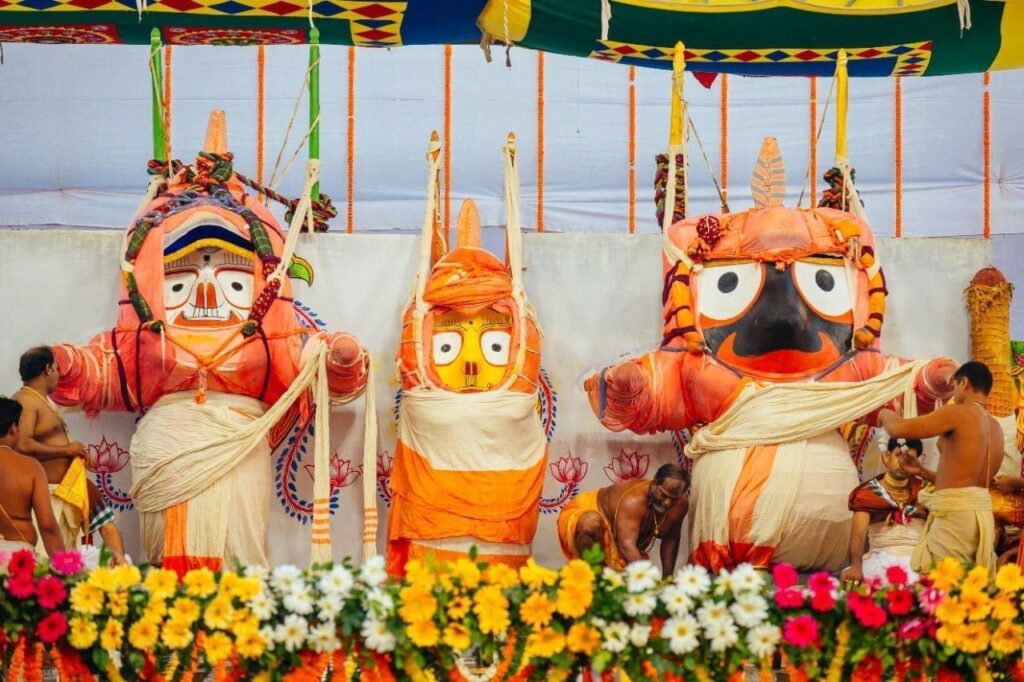In the sacred city of Puri, the annual Snana Yatra—a centuries-old ceremonial bathing ritual of Lord Jagannath—unfolded on Wednesday with grandeur and deep spiritual resonance, marking the official commencement of the Rath Yatra festival calendar.
Amid chants of ancient mantras, clanging bells, and the collective devotion of thousands, the deities—Lord Jagannath, Lord Balabhadra, and Devi Subhadra—were brought out in full public view onto the Snana Mandap, the elevated ceremonial platform inside the Jagannath Temple complex. There, they were bathed with 108 pots of sanctified water, drawn from the temple’s golden well and infused with fragrant herbs, as priests performed age-old rituals that date back hundreds of years.
An Ancient Ritual with Enduring Power
The Snana Yatra, held annually on the full moon of Jyestha month, is considered the divine birthday of Lord Jagannath. The act of bathing the deities in public is both a religious spectacle and a moment of profound theological significance—believed to cleanse and rejuvenate the divine forms, while also symbolizing purification for the countless devotees in attendance.
Following the ceremonial bath, the deities are adorned in the Hati Besa, or elephant attire, in which Lord Jagannath assumes the appearance of Lord Ganesha. This rare and deeply symbolic dress is displayed only once a year.
Soon after, the idols are led into a period of Anasara, a 15-day seclusion in which the deities are believed to fall ill from the exposure and are treated with traditional Ayurvedic preparations. During this time, the sanctum sanctorum is closed to the public and priests carry out intimate rituals to restore the divine energy.
The return of the deities to public life is celebrated with the Netrotsava (the “Festival of Eyes”) on June 26, ahead of the grand Rath Yatra procession scheduled for June 27, when the deities will be paraded in massive chariots through the streets of Puri.
A Spiritual Gathering—and a Logistical Feat
Snana Yatra draws tens of thousands of devotees to the temple city, turning Puri into a pulsating epicenter of faith and festivity. Pilgrims from across India, many barefoot and clad in white, line up for hours for a glimpse of the deities in their ceremonial form.
To manage the vast crowds and ensure security during the Yatra period, Odisha authorities have deployed over 100 platoons of police, rapid response teams, and anti-terror squads (ATS). Surveillance drones and AI-enabled monitoring systems are also being used to ensure smooth operations during what is arguably one of the world’s largest religious gatherings.
An Eternal Continuum
For those who gather at the temple or watch live streams across the country, the Snana Yatra is not just a ritual—it is a moment that links them to an ancient continuum of belief. At its heart lies the idea of divine embodiment, where gods live, fall ill, recover, and step out among their devotees.
As conch shells echoed through the temple corridors and the scent of sandalwood filled the air, one could sense the timelessness of the celebration. In a world of change, the deities of Puri continue to follow their celestial routine, inviting the faithful to join them—year after year—in rhythm with the divine.


